According to the State of Michigan, the total number of COVID cases in Michigan rose to 53,913 on May 22, an increase of 403 cases from the previous day. This total was equivalent to 540 cases per 100,000 people (Chart 4). Of those 403 cases 123 were documented in Southeastern Michigan. This means that of the new daily COVID cases Southeastern Michigan accounted for 31 percent of them, highlighting how most of the new cases continue to occur outside of the region. The five-day rolling average for the total number of COVID cases (Chart 1) reflects a smoother curve and adjusts for fluctuations in testing and/or the quality of reporting or failure to report.
Chart 2 shows that, based on the five-day rolling averages, the growth of new COVID cases in Southeastern Michigan continued to level off for the counties in region. The flattening of the COVID growth curves in Southeastern Michigan also further supports how the increase of COVID cases is slowing in the region, with cases outside the region now making up majority of the new daily COVID cases. On May 20 the number of cases in Detroit reached 10,486, the highest in the region, and Wayne County reported the second highest number of cases at 8,913. On May 20, the five-day rolling average for the number of COVID cases in Oakland County was 8,100, and Macomb County reported 6,396.
The City of Detroit had 1,574 COVID cases per 100,000 people on May 22, an increase from 1,570 the day before (Chart 3). This is based upon a reported increase of 29 new COVID cases, bringing the total number of COVID cases in Detroit to 10,587. Wayne County reported 837 cases per 100,000 people, and Oakland County had 647 cases per 100,000 people. These per capita rates were based upon 9,015 total cases for Wayne and 8,131 for Oakland. Macomb County reported 737 cases per 100,000 people, which is based upon 6,445 cases.
The daily data highlighted in these posts is from Michigan.gov/coronavirus, where data is updated daily at 3 p.m. Historical data were supplied from covidtracking.com, which republishes COVID data from the State. Additionally, the case totals do not reflect the number of people who have recovered, just those who have been infected.
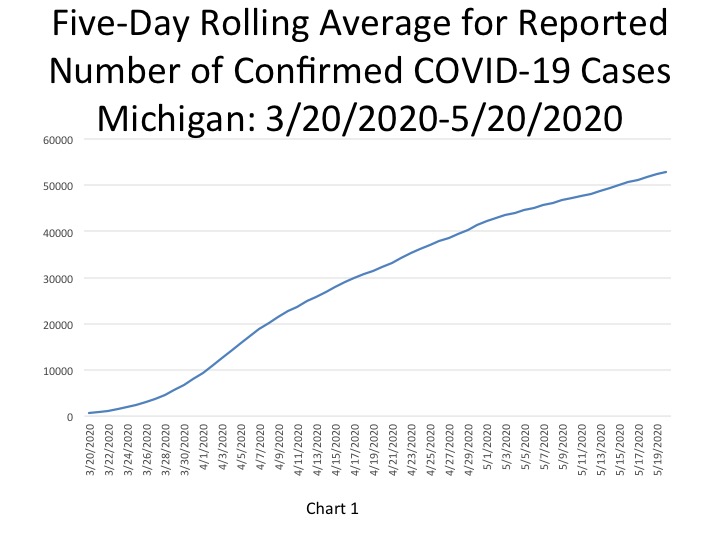
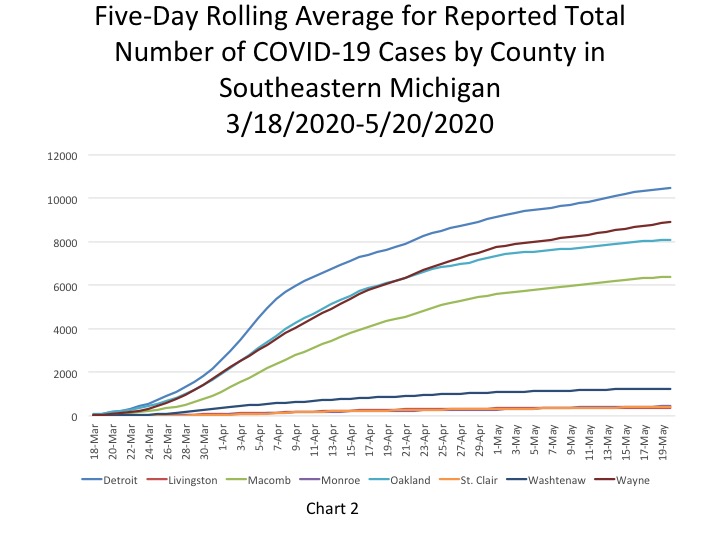
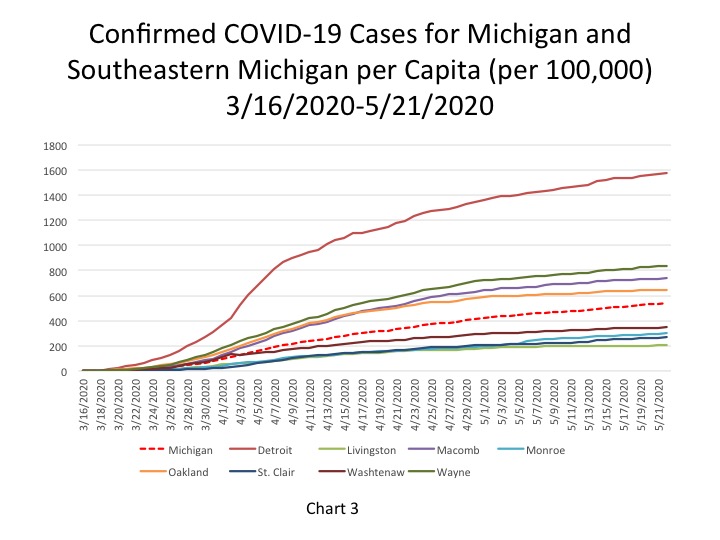
Chart 4 shows that Wayne County reported the highest number of daily cases at 60 on May 20, an increase of 2 daily cases from the day prior when it also had the highest number of daily cases. Though Wayne County increased, this chart shows that daily case numbers throughout Southeastern Michigan continue to decline.
On May 22 the per capita rate for the number of new daily COVID cases per 100,000 people was 4 for the State; this was equivalent to 403 new cases. The number of new cases the State reported on May 22 was a decrease from the day before for the second day in a row. Monroe County was the only government entity in the region to report a higher per capita rate for the number of new daily COVID cases per 100,000 people than the State. On May 22 Monroe County reported a per capita rate of 9 new COVID cases per 100,000 people, which was equivalent to 13 new cases. Detroit reported the same per capita rate as the State at 4 new daily COVID cases per 100,000 people; this was equivalent to 29 new cases. Wayne County reported 3 new COVID cases per 100,000, which was equivalent to 35 new cases. Oakland County reported a per capita rate of 0.4 new case per 100,000 people, which was equivalent to 6 new cases, and Macomb County reported a rate of 3, which was also equivalent to 25 new cases. Overall, 123 new COVID cases were reported in Southeastern Michigan on May 22. This is a decrease in the total number of daily COVID cases in Southeastern Michigan from the day prior. Wayne County (including Detroit data) had 64 new COVID cases on May 22 while Kent County had an increase of 86 new cases.
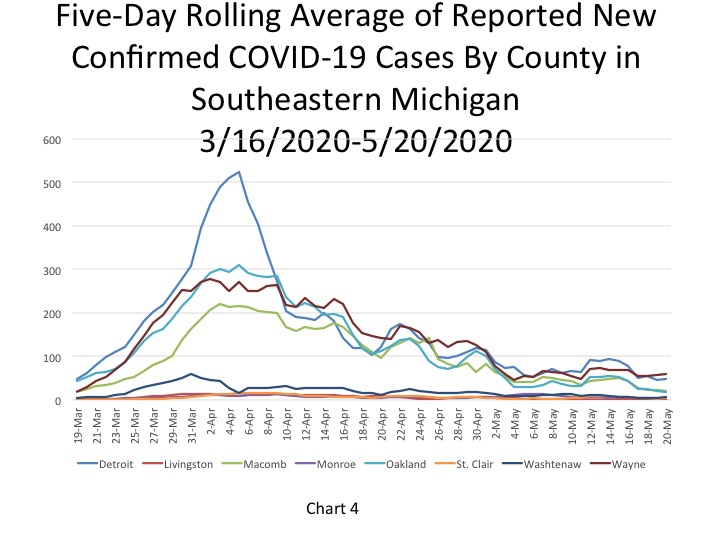
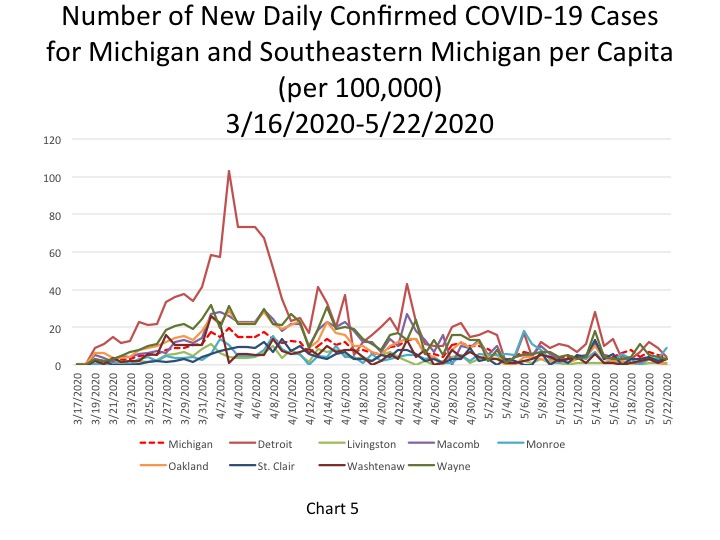
In Chart 6, the five-day rolling average for the number of deaths in Michigan shows a continuing slow increase (a lagged number of 5,056 deaths, an increase of 53 deaths). The actual reported COVID-19 on May 22 was 5,158, an increase of 29 deaths from the day prior. Of those 29 additional deaths Southeastern Michigan accounted for 16 of them.
Chart 7 (a 5-day rolling average) portrays how the total number of COVID deaths in Southeastern Michigan continues to flatten, with Detroit reporting the highest cumulative number of deaths at 1,282 on May 20. Wayne County had the second highest total at 1002 on May 20.
Chart 8 portrays the total number of COVID deaths per 100,000 people on May 22, and only the per capita rates for the State and Monroe County increased, while the other per capita rates in Southeastern Michigan remained the same. The State of Michigan had 52 COVID deaths per 100,000 people, which was equal to 5,158 total deaths. In Monroe County the per capita rate rose to 12, which represents 19 total deaths. The cumulative total of COVID deaths per 100,000 people in Detroit was 193 (representing 1,299 deaths). In Wayne County there were 95 COVID deaths per 100,000 people (1,024 total deaths), in Oakland County there were 75 deaths per 100,000 people (945 total deaths), and in Macomb County there were 88 COVID deaths per 100,000 people (776 total). Wayne County had the highest single day death count in Southeastern Michigan on May 22; 6 COVID deaths were reported. No new deaths were reported in Livingston, Oakland and St. Clair counties.
Chart 9, the five day rolling average of deaths, shows the number of new statewide deaths increased for the fourth day in a row. On May 20 the State reported 53 COVID deaths. Chart 10 shows how the number of deaths in Southeastern Michigan, except in Wayne County, have been either leveling off or decreasing. In Wayne County reported that cumulative deaths were 1,002 deaths an increase of 13 from the day prior. On May 20, Wayne County had the highest number of daily COVID deaths in the region. Detroit reported 9 daily COVID deaths, which was an increase of one from the day prior, further confirming that the number of deaths, at least in areas of Southeastern Michigan, are remaining stable and much lower than in previous weeks. On May 20, of the 53 new deaths reported 37 were reported out of Southeastern Michigan. These numbers are based on 5-day rolling averages.
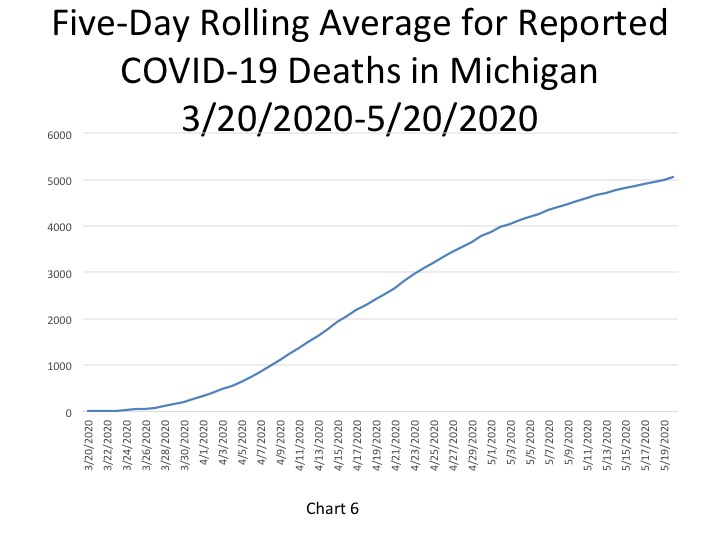
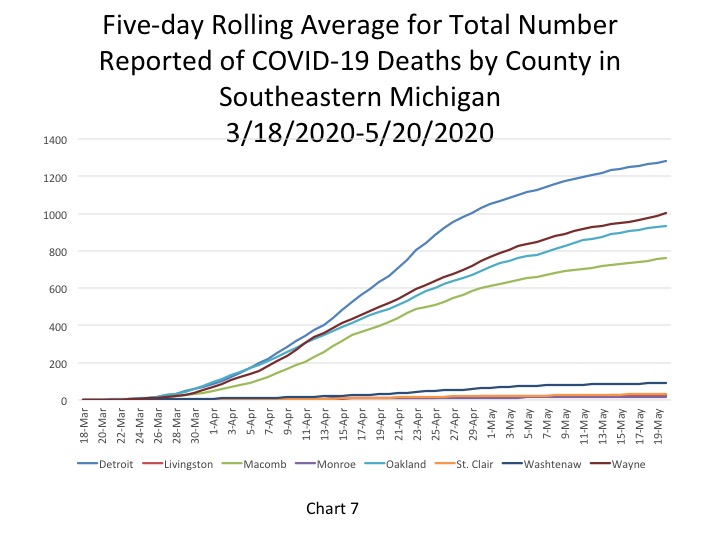
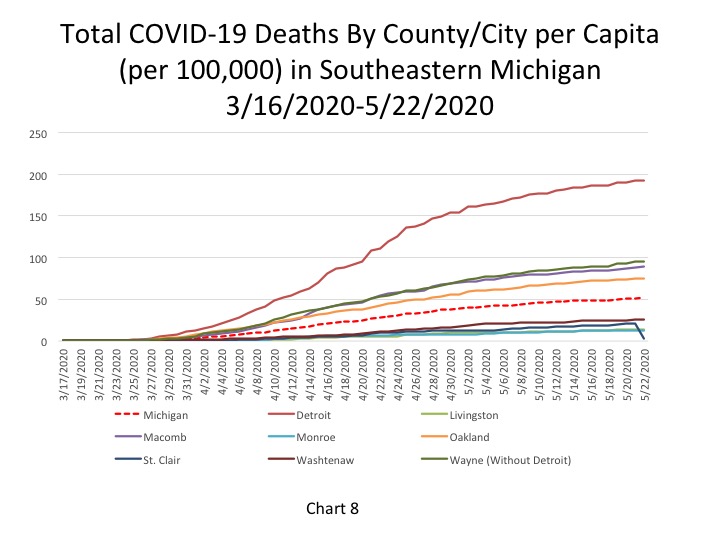
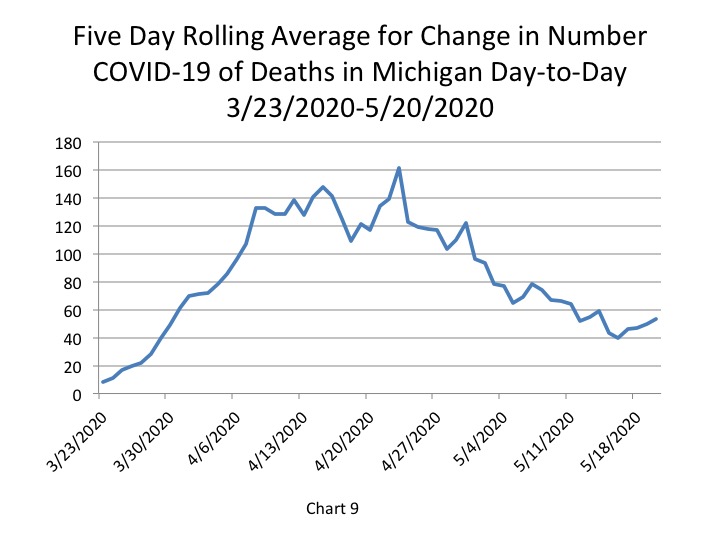
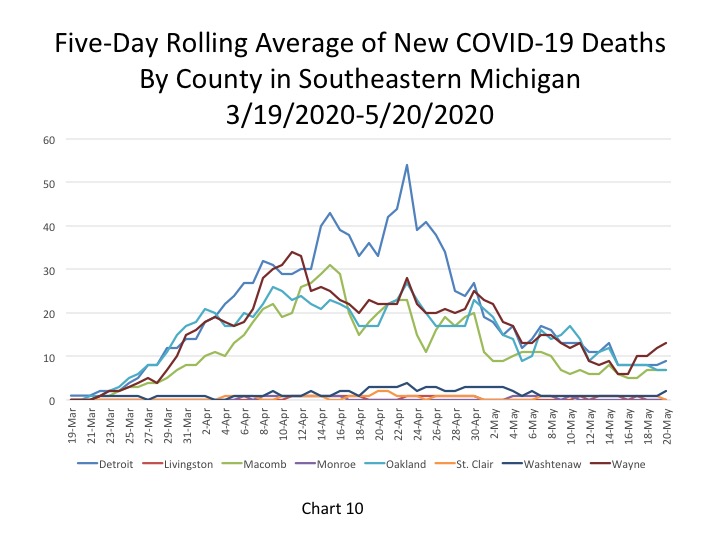
On May 22 Detroit continued to report a fatality rate of 12.2 percent, showing while it is the highest rate in the region it has leveled off. The fatality rate in Macomb County remained at 12 percent, and the State continued to report a fatality rate of 9.6 percent.
One reason we may be seeing such high fatality rates in Michigan is due to the low testing rates. When only having-presumably-a lower of number confirmed COVID cases than is actually likely due to the limited availability of tests, the fatality rate appears higher because the base comparison is smaller than it might be.
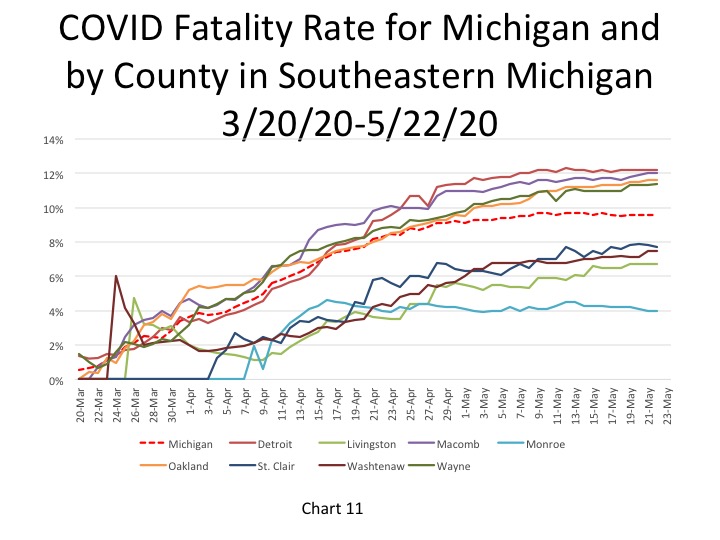
The data from May 22 shows that the number of deaths in Southeastern Michigan continues to decline, as do the number of new COVID cases. This is something Gov. Gretchen Whitmer also confirmed in her Friday press conference when she extended the Stay-at-Home order through June 12. She acknowledged the growth of new cases and deaths are on the decline, but said we, as a State, are “not out of the woods yet.”